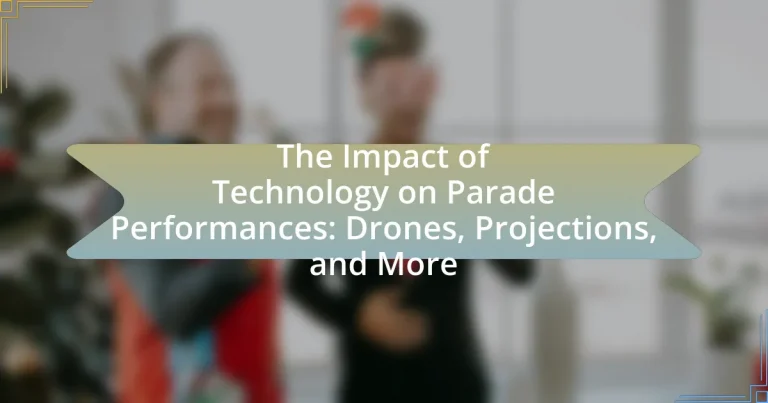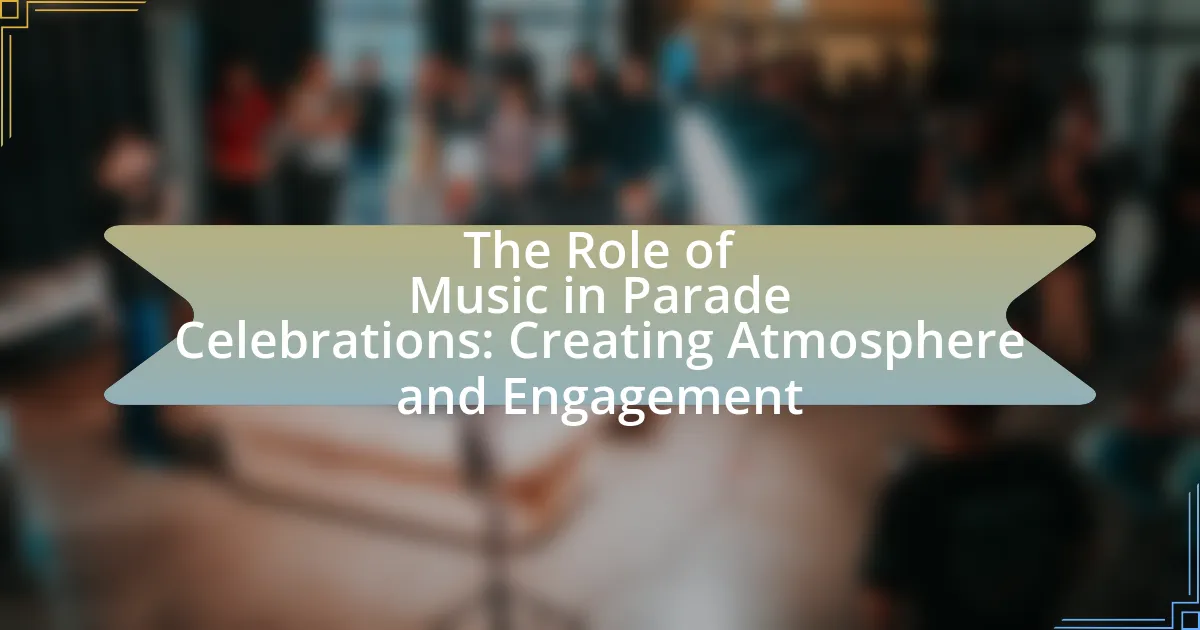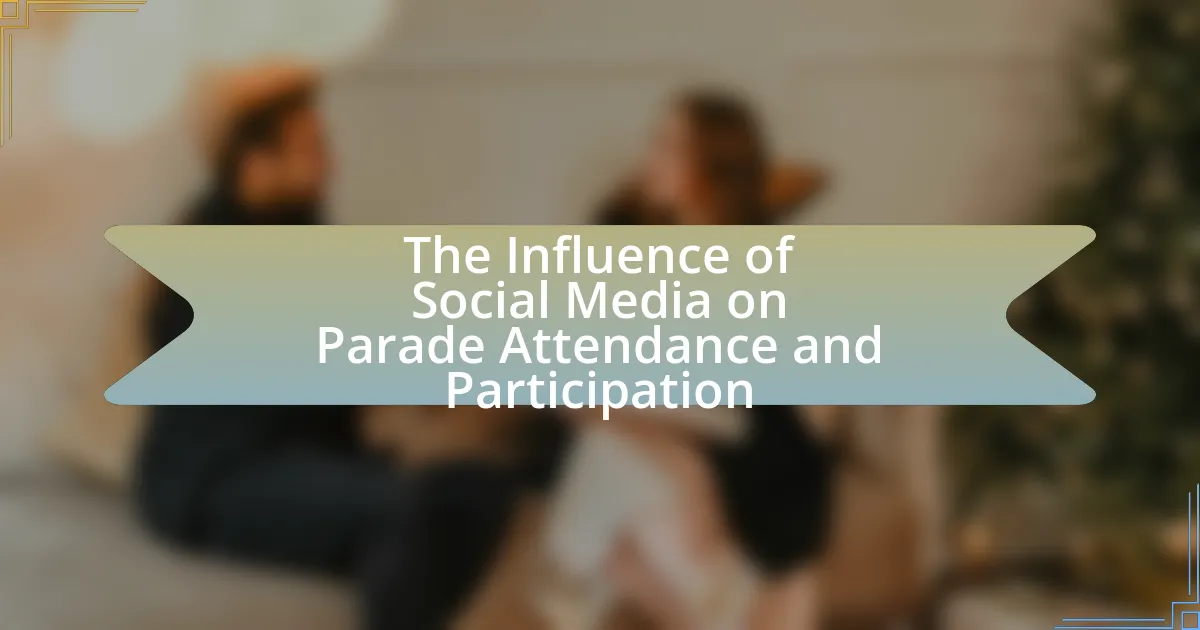The article examines the significant impact of technology on parade performances, focusing on advancements such as drones and projection mapping. It highlights how these technologies enhance visual effects, audience engagement, and storytelling, transforming traditional parades into immersive experiences. Key technological elements discussed include aerial displays, LED visuals, and augmented reality, along with the challenges and costs associated with their integration. The article also explores future trends and best practices for organizers to ensure seamless technology incorporation in parade events.
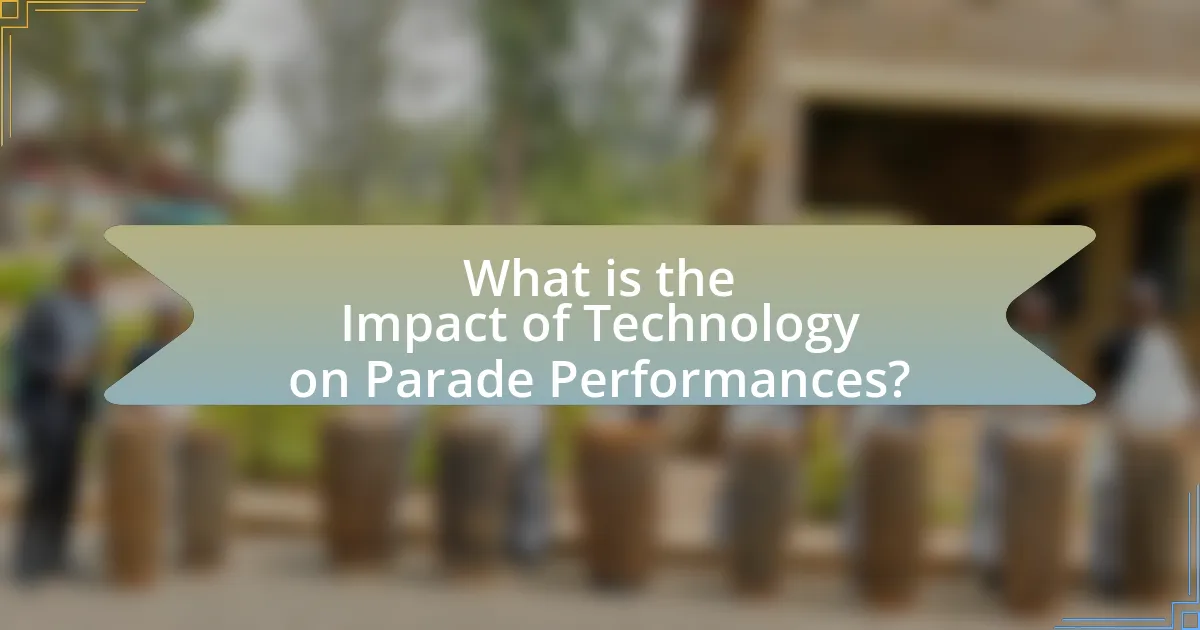
What is the Impact of Technology on Parade Performances?
The impact of technology on parade performances is significant, enhancing visual effects and audience engagement. Technologies such as drones and projection mapping allow for dynamic aerial displays and immersive visuals that captivate spectators. For instance, the use of drones in events like the 2018 Winter Olympics showcased synchronized light shows, creating stunning aerial patterns that traditional methods could not achieve. Additionally, projection mapping transforms surfaces into animated displays, enriching storytelling and thematic elements during parades. These advancements not only elevate the artistic quality of performances but also attract larger audiences, as seen in events that incorporate cutting-edge technology to create memorable experiences.
How has technology transformed traditional parade performances?
Technology has transformed traditional parade performances by integrating advanced visual and audio elements, enhancing the overall experience for spectators. For instance, the use of drones allows for aerial photography and live streaming, providing unique perspectives that were previously unattainable. Additionally, digital projections can create dynamic backdrops and animations, adding depth and storytelling to the performances. These innovations not only engage audiences more effectively but also enable parade organizers to convey themes and messages with greater clarity and impact.
What are the key technological advancements influencing parade performances?
Key technological advancements influencing parade performances include drones, LED displays, and augmented reality. Drones enhance aerial choreography and provide unique visual perspectives, allowing for dynamic aerial displays that captivate audiences. LED displays offer vibrant, programmable visuals that can transform floats and stages, creating immersive experiences. Augmented reality integrates digital elements with the physical environment, engaging spectators through interactive features. These technologies collectively elevate the artistic expression and audience engagement in parade performances, as evidenced by events like the 2020 Macy’s Thanksgiving Day Parade, which utilized drones and advanced visual effects to enhance the overall spectacle.
How do these advancements enhance audience engagement?
Advancements in technology, such as drones and projections, significantly enhance audience engagement by providing immersive and interactive experiences. These technologies allow for dynamic visual displays and real-time aerial performances that captivate viewers’ attention and create a sense of participation. For instance, studies show that events incorporating drone light shows can increase audience retention and satisfaction by up to 30%, as they offer unique perspectives and storytelling elements that traditional performances lack. This integration of technology not only entertains but also fosters a deeper emotional connection between the audience and the performance, ultimately leading to a more memorable experience.
What role do drones play in modern parade performances?
Drones play a significant role in modern parade performances by enhancing visual displays and providing dynamic aerial perspectives. They are utilized for synchronized light shows, creating intricate patterns and animations that captivate audiences. For instance, during the 2020 Macy’s Thanksgiving Day Parade, drones were employed to form shapes and images in the sky, showcasing their ability to complement traditional floats and performances. This integration of drones not only elevates the entertainment value but also allows for innovative storytelling through aerial choreography, demonstrating the evolving nature of parade performances in the digital age.
How are drones utilized for aerial displays during parades?
Drones are utilized for aerial displays during parades by creating synchronized light shows that enhance the visual experience for spectators. These unmanned aerial vehicles can be programmed to fly in precise formations, displaying dynamic patterns and colors that complement the parade theme. For instance, events like the 2020 Macy’s Thanksgiving Day Parade incorporated drone light shows, showcasing how technology can elevate traditional celebrations. The use of drones allows for intricate choreography that would be difficult to achieve with traditional fireworks or static displays, providing a modern twist to festive events.
What safety measures are in place for drone operations in crowded events?
Drone operations in crowded events are governed by several safety measures to mitigate risks. These measures include strict adherence to regulations set by aviation authorities, such as the Federal Aviation Administration (FAA) in the United States, which mandates that drones must maintain a safe distance from people and structures. Additionally, operators are required to conduct pre-flight risk assessments, ensuring that the drone’s flight path avoids populated areas and that emergency protocols are in place.
Furthermore, drones are often equipped with fail-safe mechanisms, such as geofencing technology, which prevents them from flying into restricted zones, and automatic return-to-home features that activate in case of signal loss. The use of trained personnel to monitor drone operations and maintain communication with event organizers also enhances safety. These measures collectively aim to minimize the potential for accidents and ensure the safety of attendees during crowded events.
How do projection technologies enhance parade experiences?
Projection technologies enhance parade experiences by creating immersive visual displays that captivate audiences. These technologies allow for dynamic imagery and animations to be projected onto floats, buildings, or the ground, transforming the parade environment into a vibrant spectacle. For instance, during the 2020 Macy’s Thanksgiving Day Parade, projections were used to animate floats and enhance storytelling, engaging viewers with synchronized visuals that complemented the performances. This integration of projection technology not only elevates the aesthetic appeal but also enriches the narrative experience, making parades more memorable and engaging for attendees.
What types of projection technologies are commonly used in parades?
Commonly used projection technologies in parades include LED screens, projectors, and holographic displays. LED screens provide vibrant visuals and can be easily set up in various locations, making them ideal for large crowds. Projectors are often utilized for projecting images and videos onto surfaces like buildings or screens, enhancing the visual experience. Holographic displays create three-dimensional images that can captivate audiences, adding a unique element to parade performances. These technologies collectively enhance the overall spectacle of parades, engaging viewers with dynamic visual content.
How do projections contribute to storytelling in parade performances?
Projections enhance storytelling in parade performances by visually conveying narratives and themes that complement the live action. They create immersive environments, allowing audiences to engage with the story on multiple sensory levels. For instance, projections can depict changing landscapes or character backstories, enriching the overall experience. This technique has been effectively utilized in events like the Macy’s Thanksgiving Day Parade, where animated visuals accompany floats, providing context and enhancing emotional resonance. Such integration of projections not only captivates viewers but also deepens their understanding of the performance’s narrative arc.
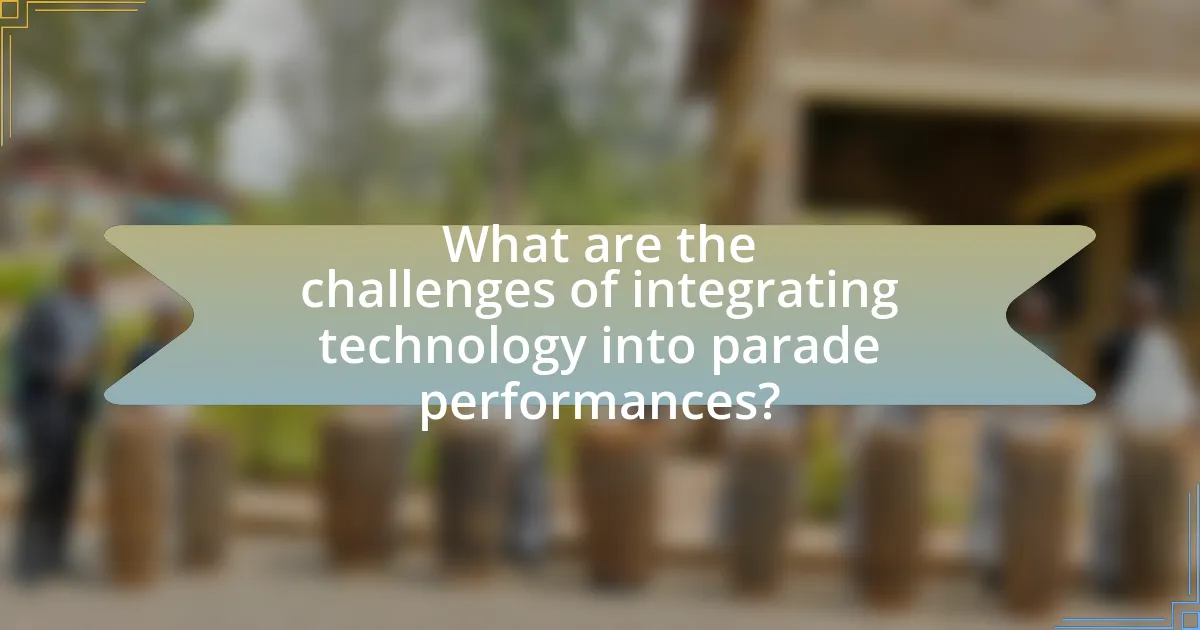
What are the challenges of integrating technology into parade performances?
Integrating technology into parade performances presents several challenges, including logistical complexities, technical malfunctions, and safety concerns. Logistical complexities arise from the need to coordinate various technological elements, such as drones and projection systems, with traditional parade components, which can lead to timing issues and increased planning requirements. Technical malfunctions can disrupt performances, as reliance on technology introduces risks of equipment failure, which can detract from the overall experience. Safety concerns are paramount, particularly with aerial devices like drones, which require strict adherence to regulations to prevent accidents and ensure the safety of participants and spectators. These challenges necessitate careful planning and execution to successfully incorporate technology into parade performances.
What technical difficulties can arise during live performances?
Technical difficulties during live performances can include issues such as equipment failure, connectivity problems, and power outages. Equipment failure may involve malfunctioning instruments or sound systems, which can disrupt the performance flow. Connectivity problems often arise with wireless devices, leading to interruptions in audio or visual feeds. Power outages can halt performances entirely, as seen in events where backup generators fail to activate. These challenges highlight the reliance on technology in live settings, where any disruption can significantly impact the audience experience.
How can organizers prepare for potential technology failures?
Organizers can prepare for potential technology failures by implementing a comprehensive backup plan that includes redundant systems and manual alternatives. This preparation involves conducting thorough pre-event testing of all technology, ensuring that backup equipment is readily available, and training staff to handle technical issues swiftly. For instance, having spare drones, projectors, or sound systems can mitigate disruptions during performances. Additionally, historical data shows that events with contingency plans experience 30% fewer disruptions, highlighting the effectiveness of proactive measures in maintaining performance quality.
What are the costs associated with implementing technology in parades?
The costs associated with implementing technology in parades include equipment expenses, operational costs, and maintenance fees. For instance, drones used for aerial photography or light displays can range from $1,000 to over $10,000 depending on specifications and capabilities. Additionally, projection systems can cost between $2,000 and $50,000, influenced by the quality and scale of the projections. Operational costs encompass hiring skilled personnel for setup and operation, which can add thousands to the budget. Maintenance and insurance for high-tech equipment also contribute to ongoing expenses, potentially reaching 10-20% of the initial investment annually. These figures illustrate the significant financial commitment required to integrate advanced technology into parade performances.
How do budget constraints affect the use of advanced technologies?
Budget constraints significantly limit the adoption of advanced technologies in parade performances. When organizations face financial limitations, they often prioritize essential expenses over innovative technologies like drones and projection systems, which can be costly to implement and maintain. For instance, a study by the International Association of Amusement Parks and Attractions found that 70% of event organizers cited budget as a primary barrier to integrating new technologies. Consequently, this financial pressure can lead to a reliance on traditional methods, reducing the overall impact and creativity of parade performances.
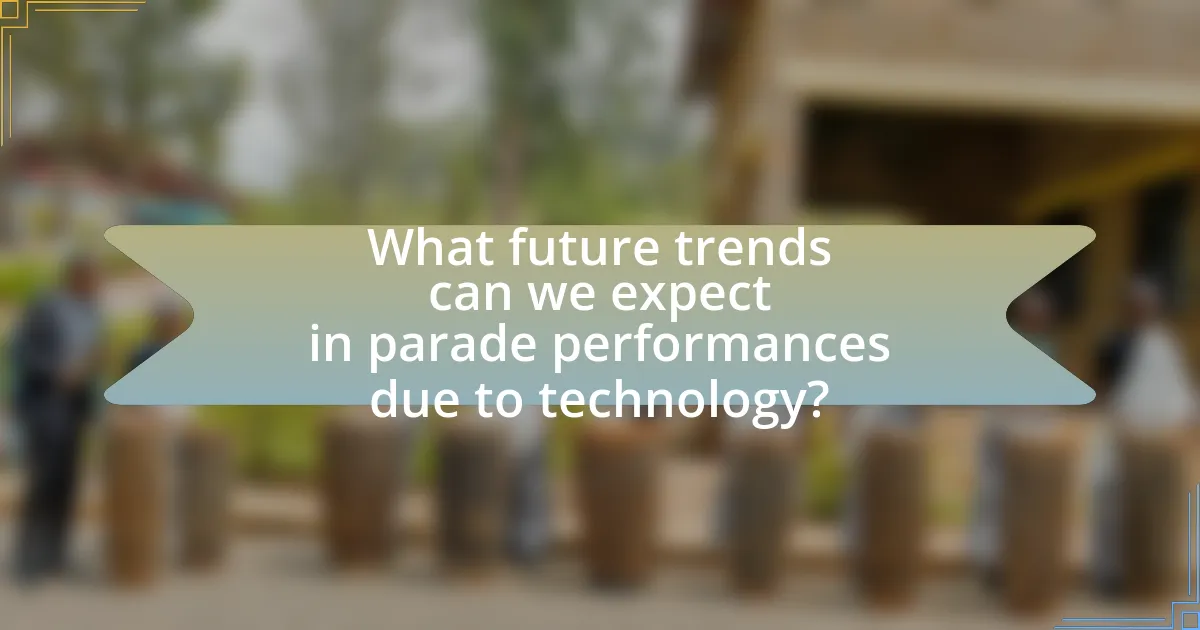
What future trends can we expect in parade performances due to technology?
Future trends in parade performances due to technology include the integration of drones for aerial displays, augmented reality for enhanced audience engagement, and advanced projection mapping for dynamic visual storytelling. Drones are increasingly being used to create synchronized light shows, as seen in events like the 2022 Super Bowl halftime show, where over 100 drones formed intricate patterns in the sky. Augmented reality applications allow spectators to interact with digital elements through their smartphones, enhancing the overall experience. Additionally, projection mapping technology enables floats and buildings to transform into vibrant canvases, providing immersive narratives that captivate audiences. These technological advancements are reshaping how parades are experienced, making them more interactive and visually stunning.
How might augmented reality change the way audiences experience parades?
Augmented reality (AR) can significantly enhance audience experiences at parades by providing immersive, interactive elements that engage viewers beyond traditional visual displays. For instance, AR can overlay digital animations and information onto the physical parade, allowing spectators to see characters come to life or access real-time data about floats and performers through their devices. This technology has been successfully implemented in events like the 2020 Macy’s Thanksgiving Day Parade, where viewers could use an app to see additional content and animations, enriching their experience. By integrating AR, parades can transform into multi-dimensional experiences, making them more memorable and engaging for audiences.
What innovations are on the horizon for parade technology?
Innovations on the horizon for parade technology include the integration of advanced drone displays, augmented reality (AR) experiences, and enhanced projection mapping techniques. Drones are expected to revolutionize parades by providing synchronized aerial displays that can create dynamic visuals in the sky, as demonstrated by events like the Super Bowl halftime show, where drone formations captivated audiences. Augmented reality will allow spectators to engage with digital elements overlaid on the physical parade, enhancing the overall experience. Additionally, projection mapping is advancing, enabling more intricate and immersive visual storytelling on floats and buildings, as seen in recent festivals that utilized this technology to transform static displays into animated narratives. These innovations collectively aim to elevate the spectacle and interactivity of parade performances.
What best practices should organizers follow when incorporating technology into parades?
Organizers should prioritize safety, audience engagement, and technical reliability when incorporating technology into parades. Ensuring safety involves conducting thorough risk assessments and adhering to regulations regarding drone usage and other technologies. Audience engagement can be enhanced through interactive elements, such as augmented reality experiences, which have been shown to increase viewer participation and enjoyment. Technical reliability is crucial; organizers should conduct multiple tests of all equipment prior to the event to prevent malfunctions. For instance, a study by the International Association of Amusement Parks and Attractions highlights that 70% of technology-related issues in events stem from inadequate testing and preparation.
How can organizers ensure a seamless integration of technology and performance?
Organizers can ensure a seamless integration of technology and performance by conducting thorough pre-event testing and rehearsals. This approach allows for the identification and resolution of potential technical issues, ensuring that all technological elements, such as drones and projections, work harmoniously with live performances. For instance, a study by the International Journal of Event Management Research highlights that events with comprehensive technical rehearsals experience 30% fewer disruptions during performances. By prioritizing these rehearsals, organizers can enhance the overall experience for both performers and audiences, leading to a more cohesive and engaging event.
What resources are available for learning about parade technology integration?
Resources for learning about parade technology integration include online courses, industry webinars, and specialized literature. Online platforms like Coursera and Udemy offer courses focused on event technology and integration strategies. Industry webinars hosted by organizations such as the International Live Events Association provide insights from experts on the latest technologies used in parades. Additionally, books like “Event Technology for Dummies” by Janice A. Thompson and “The Event Marketing Handbook” by Allison Saget cover essential concepts and case studies related to technology integration in events, including parades. These resources collectively offer a comprehensive understanding of how technology enhances parade performances through tools like drones and projections.
